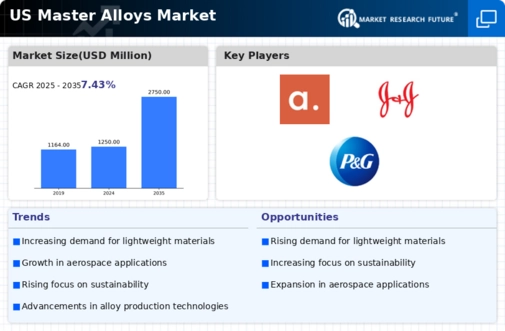The master alloys market is currently characterized by a competitive landscape that is both dynamic and multifaceted. Key growth drivers include the increasing demand for lightweight materials in the aerospace and automotive sectors, alongside a growing emphasis on sustainability and recycling. Major players such as Alcoa Corporation (US), Aleris Corporation (US), and Kaiser Aluminum Corporation (US) are strategically positioned to leverage these trends. Alcoa Corporation (US) focuses on innovation in aluminum production processes, aiming to enhance efficiency and reduce environmental impact. Aleris Corporation (US) emphasizes partnerships with automotive manufacturers to develop advanced alloys tailored for electric vehicles, while Kaiser Aluminum Corporation (US) is expanding its product offerings to include high-performance alloys that cater to the aerospace industry. Collectively, these strategies contribute to a competitive environment that is increasingly oriented towards technological advancement and sustainability.
In terms of business tactics, companies are localizing manufacturing to reduce lead times and optimize supply chains. This approach is particularly relevant in a moderately fragmented market where several players vie for market share. The collective influence of key players is significant, as they not only drive innovation but also set industry standards that smaller competitors must follow. The focus on supply chain optimization is critical, especially in light of recent global disruptions, prompting companies to reassess their operational frameworks.
In November 2025, Alcoa Corporation (US) announced a partnership with a leading automotive manufacturer to develop a new line of lightweight alloys aimed at enhancing vehicle efficiency. This strategic move is likely to position Alcoa at the forefront of the automotive sector's shift towards more sustainable materials, potentially increasing its market share in this lucrative segment. The collaboration underscores the importance of aligning product development with industry needs, particularly in the context of rising environmental regulations.
In October 2025, Kaiser Aluminum Corporation (US) unveiled a new production facility dedicated to the manufacturing of high-strength alloys for aerospace applications. This investment not only signifies Kaiser’s commitment to expanding its capabilities but also reflects a broader trend of increasing domestic production in response to supply chain vulnerabilities. The facility is expected to enhance the company’s competitive edge by providing faster turnaround times and improved product quality, which are critical in the aerospace sector.
In September 2025, Aleris Corporation (US) launched a new range of master alloys specifically designed for the electric vehicle market. This initiative is indicative of the growing trend towards electrification in the automotive industry and positions Aleris as a key player in this emerging segment. By focusing on the development of specialized alloys, Aleris is likely to capture a significant share of the market, as manufacturers seek materials that enhance performance and sustainability.
As of December 2025, the competitive trends in the master alloys market are increasingly defined by digitalization, sustainability, and the integration of AI technologies. Strategic alliances are becoming more prevalent, as companies recognize the need to collaborate in order to innovate and meet evolving market demands. The shift from price-based competition to a focus on innovation, technology, and supply chain reliability is evident, suggesting that future competitive differentiation will hinge on the ability to adapt to these trends. Companies that prioritize sustainable practices and technological advancements are likely to emerge as leaders in this evolving landscape.














Leave a Comment